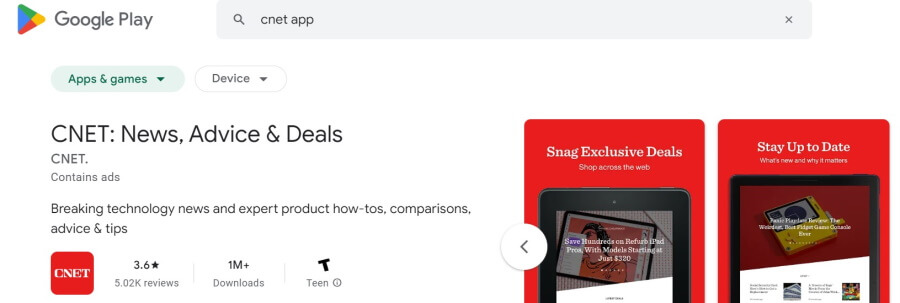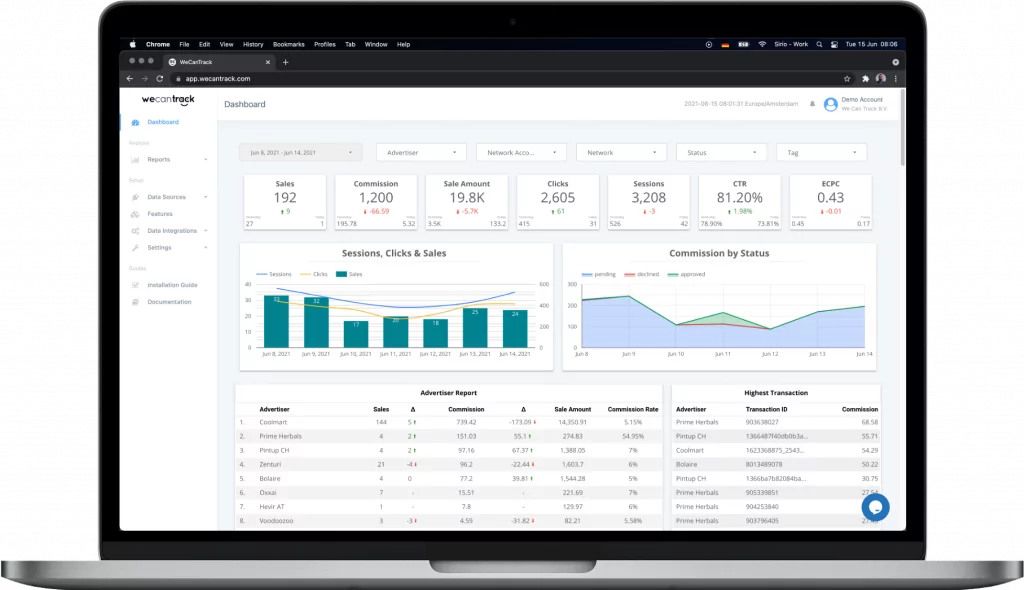Marketers could place ads on public transport that users carry almost everywhere they go, which could generate additional commissions for them.
It is essential to understand that you don’t have to stick to your website or pay only for ads; instead, as an affiliate, you can sell the products or services anywhere online. Examples include blogs or video-sharing sites.
In this article, you will discover the foundation of In-App Affiliate Marketing, which examines its working, procuring, challenges, and solutions.
In-App affiliate marketing overview
What Is In-App Affiliate Marketing?
In-app affiliate marketing is a type of performance-based marketing where an affiliate promotes a business’s products or services within an app and earns a commission for each successful conversion.
This type of marketing is a way for app developers and businesses to monetize their apps. Of course, those same businesses and developers can leverage affiliate marketing for their promotion and drive more sales or leads through referral marketing.
In this guide, we will take a look at the steps involved in setting up a successful in-app affiliate program, different methods for tracking and conversions, and the benefits of using in-app affiliate networks.
At the same time, we’ll discuss all the factors that businesses need to take into account to make successful use of affiliate marketing to promote their products or services.

In-app affiliate marketing offers advertisers precise targeting and user engagement within mobile ecosystems. For publishers, it opens new revenue streams but requires seamless integration with diverse app environments.
Being Successful With In-App Affiliate Marketing
If you’re already an affiliate marketer, you know it’s far from an easy road to success.
Whether you choose the path of building an SEO-friendly website, monetizing a newsletter, or building an audience on YouTube, Pinterest, or any other social media platform, it takes time to attract the traffic that will genuinely earn you an income.
Leveraging in-app affiliate marketing is no different. So, let’s look at the steps you need to take to succeed.
- Understand Your Audience: Start by thoroughly understanding your app’s user base. Identify their demographics, preferences, and behaviors to ensure that the affiliate offers you promote align with their interests and needs.
- Choose Reputable Affiliate Programs: Select affiliate programs that offer products or services relevant to your audience and are reputable in terms of commission rates, tracking reliability, and payment schedules. Research different affiliate networks or platforms to find the best fit for your app.
- Integrate Affiliate Offers Seamlessly: Integrate affiliate offers seamlessly within your app’s user experience to avoid disrupting the flow or appearing overly promotional. Natural integration ensures higher engagement and conversion rates.
- Provide Value: Ensure that the affiliate offers you promote provide genuine value to your users. Focus on promoting products or services that solve a problem, fulfill a need, or enhance the user experience, rather than solely aiming for sales.
- Disclose Affiliate Relationships: Be transparent with your users about your affiliate partnerships. Clearly disclose any affiliate links or sponsored content to maintain trust and transparency, which are crucial for long-term success.
- Track and Analyze Performance: Implement robust tracking mechanisms to monitor the performance of your affiliate marketing campaigns. Analyze key metrics such as clicks, conversions, and revenue generated to identify what works best and optimize your strategies accordingly.
- Optimize for Conversion: Continuously optimize your affiliate marketing strategies based on performance data and user feedback. Experiment with different promotional methods, messaging, and placements to maximize conversion rates and revenue.
- Focus on User Experience: Prioritize the user experience above all else. Ensure that affiliate promotions enhance, rather than detract from, the overall app experience. Avoid intrusive or irrelevant ads that may alienate users and lead to churn.
- Stay Compliant with Regulations: Get acquainted to the set of the rules and compliance lines of the affiliate marketing industry, e.g. the FTC Guidelines in the United States. Make sure your promotional approaches are in line with legal conditions not to be subject to it. The penalties can vary form warnings to fines.
- Build Relationships with Partners: Create a solid rapport with your affiliate friends by often talking to each other, sharing your feedback, and working on successful promotional strategies in unison. Shared gains can bring about fairer price-table, higher commissions, and higher revenues in long-term.
The Benefits Of Using Existing Affiliate Networks
The easiest way is to subscribe to an existing affiliate network that handles all this technical stuff. Here is a list of benefits of using existing affiliate networks.
Access to a Diverse Range of Advertisers and Offers: Affiliate networks typically have a vast pool of advertisers offering various products and services across different industries.
This diversity provides app developers numerous options, ensuring they can find relevant and high-converting offers for their audience.
Streamlined Partner Discovery and Management: Affiliate networks simplify finding and managing affiliate partnerships.
They offer centralized platforms where developers can easily search for advertisers, apply to affiliate programs, track performance, and manage commissions all in one place, saving time and effort.
Built-in Tracking and Analytics Tools: Affiliate networks provide developers with robust tracking and analytics tools to monitor the performance of their affiliate marketing campaigns.
These tools offer insights into key metrics such as clicks, conversions, and revenue, enabling developers to optimize their strategies for better results.
Trust and Credibility: Established affiliate networks have built a reputation for trust and credibility within the industry.
Negotiated Commission Rates and Terms: Affiliate networks often negotiate favorable commission rates and terms with advertisers on behalf of their affiliates.
Technical Support and Assistance: Affiliate networks typically offer technical support and assistance to their affiliates, helping them troubleshoot issues, implement tracking codes correctly, and optimize their campaigns for better performance.
This support can be invaluable, especially for developers new to affiliate marketing or facing technical challenges.
Payment Processing and Timely Payments: Affiliate networks handle payment processing on behalf of advertisers, ensuring that affiliates receive their commissions promptly.
This eliminates the hassle of chasing payments from individual advertisers and provides developers with peace of mind, knowing they will be compensated for their efforts promptly.
Compliance and Regulation Adherence: Affiliate networks typically stay updated on regulatory requirements and industry best practices related to affiliate marketing.
Tactics To Drive Traffic And Optimize Conversions
Several tactics can be used to drive traffic and optimize conversions. One popular tactic is to use social media platforms to promote your app and get more installs and users for your in-app affiliate program.
This can be done by creating a social media account and promoting your app through posts and ads.
Other tactics include email marketing, content marketing, and influencer marketing. Getting influencers to promote your app is a great way to get started when your app is brand new, and you don’t have a lot of reach and exposure as of yet.
Analyzing The Value Of Incentivizing Affiliates
This one is particularly interesting for businesses that are leveraging affiliate marketing to sell their products. Remember what we said about tracking and analyzing who your best promoters are? Here’s why.

Examples Of In-App Affiliate Marketing
The easiest way of monetizing in-app affiliate marketing is by promoting affiliate links amongst the users of your app to monetize your traffic.
You could also use in-app affiliate marketing in more creative ways to boost your reach and increase your number of users. Examples include the following types of apps:
Product review app
Include product reviews, how-to information, and industry news to help your audience make shopping decisions and stay informed about new products and trends.
An example of a highly successful review website and app is CNET.

The idea to create CNET was born in 1993 by Halsey Minor and Shelby Bonnie, and the company went public on July 3, 1996.
In 2008, CBS acquired CNET, and in 2020 Red Ventures bought CNET from ViacomCBS for $500 million. CNET’s top monetization methods are affiliate marketing and ads.
Their app has been downloaded more than 1 million times on Google Play. Although we cannot see their download statistics on the App Store, they have over 2.4K ratings (averaging 4.4/5.00), which suggests their app is also popular on that platform.
CNET uses many platforms to reach its target audience, not only its app. They have around 67 million website visitors (51 million from the US) and get 90 million video views monthly. And as if that is not impressive enough, they have 14 million social media followers.
Travel app
Provide users with price comparisons on flights, hotels, and car hire to help them make informed decisions and prevent them from overpaying.
In addition, have an in-app affiliate marketing component, paying users a commission when they sign up as an affiliate and getting others to use the app.
Kayak is an example of a highly successful travel comparison site and app in the travel niche.

Kayak was founded in January 2004 by Steve Hafner and Paul English, who invested $1 million each in seed capital and raised an additional $5 million from General Catalyst.
In July 2012, Kayak became a public company and was acquired later that same year by Priceline (now called Booking Holdings) for $2.1 billion.
The Kayak app searches hundreds of travel sites, showing users travel choices on flights, hotels, and car hire. And there are special app-only deals that allow users to save more.
The app also sends notifications to your phone when prices for your next trip have dropped and status alerts on flights and check-in changes.
Kayak monetizes its app through affiliate marketing and ads. In addition, they have an affiliate program that pays affiliates up to 50% commission on bookings for flights, hotels, cars, and holiday packages.
With over 10 million downloads and 261K reviews (averaging 4.6/5.0) on Google Play and a 4.8/5.0 rating on App Store after 363K ratings, this app is a favorite for many travel enthusiasts and frequent flyers.
Shopping app
Partner with merchants and provide users with coupons, and enable them to earn cashback or discounts on their purchases.
Users could also earn rewards if they share the app with their friends through a referral link and their friends proceed to download it.
An example of a successful cashback website and app is BeFrugal.

BeFrugal was founded in 2009 by Jon Lal as an online coupon and introduced cashback rewards in 2011. By 2017 the company hit $1 billion in sales, saving consumers an average of $27 per order.
Today, BeFrugal offers up to 40% cash back for online purchases at 5,000+ stores and coupons for over 50,000 stores, including the top 500 online stores in the United States.
Cashback payment methods include checks, direct deposit, PayPal, and gift cards.
BeFrugal monetizes its app through affiliate marketing and ads.
The app has been downloaded over 100K on Google Play and is rated 4.2/5.0 after 3.4K reviews. And they have over 5.9K ratings (averaging 4.7/5.0) on the App Store.
Additional ideas
The above examples only scratch the surface of in-app affiliate marketing. Here are some additional ideas on how to get your users to promote your app:
Mobile gaming app – Include in-app purchases for virtual currency or extra lives. You could allow players to earn rewards in exchange for promoting the app to their friends through a unique referral link.
Educational app – Allow users to earn access to premium content by sharing the app with their friends through a referral link.
Fitness app – Enable users to earn credits or discounts on fitness gear by sharing products or the app with friends through a referral link.
By now, you probably have one question: How do I create an app suitable for in-app affiliate marketing?
Building an app from scratch typically requires extensive coding experience or a large budget.
For example, creating an app similar to Kayak can be time-consuming and prohibitively expensive. And you should probably not even consider building a gaming app unless you are passionate about the gaming niche and have deep pockets.
However, there are app templates available that you can customize without any coding experience. And if you get stuck or the app does not meet all your requirements, you’ll find the creator is usually more than willing to do custom design work.
Final Thoughts
In-app affiliate marketing is an effective way for businesses to monetize their apps and drive more sales or leads through referral marketing.
Social media, email, content, and influencer marketing may drive more traffic to your app and optimize conversions.
Remember that incentivizing affiliates can also be a great way to drive more conversions. In-app affiliate marketing can be applied to various industries and apps, from mobile gaming to shopping, education, travel, and more. The possibilities are endless.




